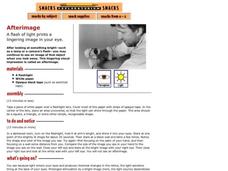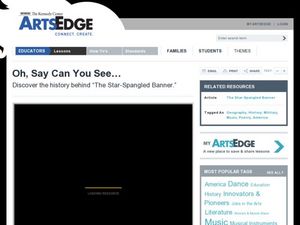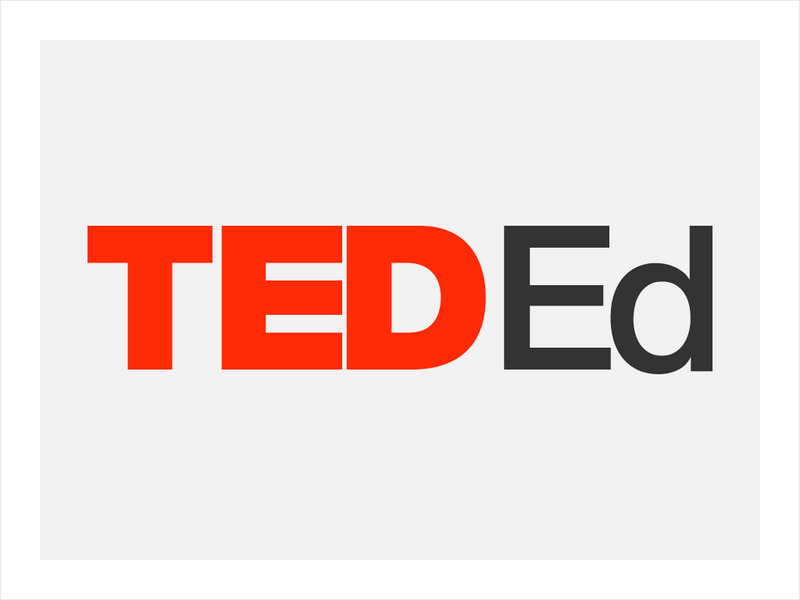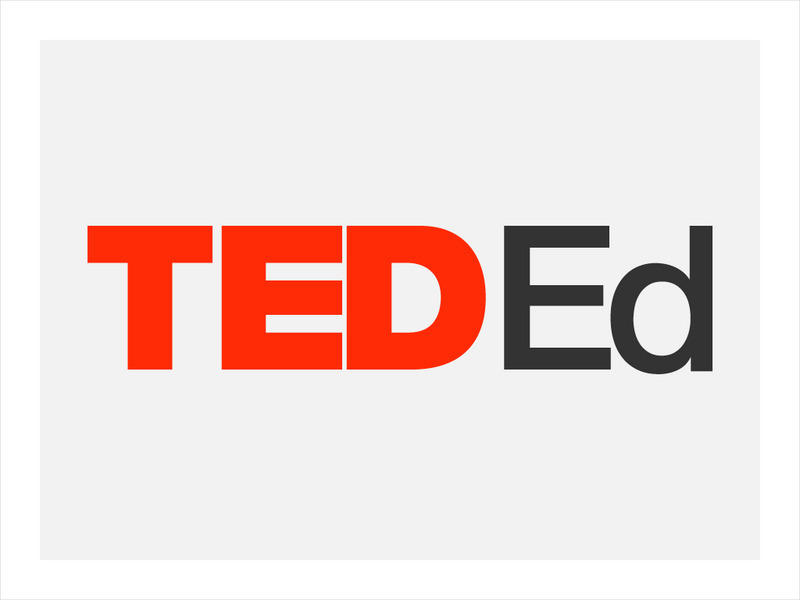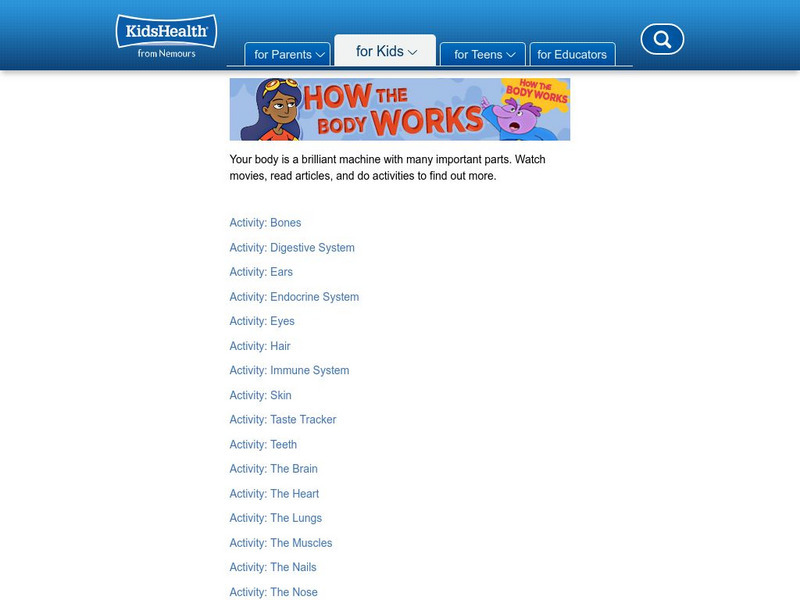University of Minnesota
Blind Spot
Your eyes each work independently, so how do we only see one image? The quick hands-on experiment encourages young scientists to test their blind spots on each eye individually. After learning where the blind spot is and why it exists,...
Exploratorium
Afterimage
To illuminate how afterimage occurs, create a star, square, or other geometric-shaped light for learners to look at for 30 seconds. Then, have them explain what they see as they shift their focus to a blank wall. A full explanation of...
Scholastic
Study Jams! The Senses: Seeing
What will viewers see when they watch this video about vision? They will observe RJ and Sam hanging out during a power outage with Rookie, the dog. The boys discuss the structure of the eye (pupil, iris, cornea, lens, retina, optic...
Science Friday
Pinhole Viewer
Take a peep into optics. Pupils watch a video about a large Polaroid camera before building pinhole viewers. The scholars then create different types of viewers and compare them to determine which provides the best image.
Nuffield Foundation
Investigating How We See Colour
Can you eyes be fooled into seeing colors that aren't actually there? Budding scientists view a presentation that addresses this topic. They explore how their eyes interpret color through the retinas and messages sent to the brain. They...
Nemours KidsHealth
Vision
From the iris and retina to glasses and contact lenses, learners will be excited to see what activities are in store for them as they learn about the complex organ of the human eye.
Exploratorium
Seeing Your Retina
Using a dimmed flashlight, life science learners can see the network of blood vessels that line the back of their eye. Darken the room and let them try this activity as part of your unit on the eyeball. Also consider some of the other...
Curated OER
Light 3: All Those Seeing Color, Say Eye!
Middle schoolers explore the nature of light. They use on-line articles and a worksheet to explore the roles of the eye and brain in the perception of color. They draw and label a diagram illustrating the movement of light.
Curated OER
Light, Colors, and Vision
Third graders experience optic illusions by creating flipbooks. For this optics lesson, 3rd graders view a demonstration of the workings of rods and cones using a camera. They are shown an optical illusion and work to create their own...
Curated OER
Light Lab
In this light and the eye learning exercise, students perform eight tests to show the blind spot in the human eye, to demonstrate Benham's disk, to show how polarized lenses work, to show how light scatters, to demonstrate fiber optic,...
Curated OER
The Light for Sight
In this eye and light activity, learners make models of the eye using black and white cardboard, a light source, and a bowl of water. They explain how each part of the model corresponds to a part of the eye. Students answer 4 discussion...
Curated OER
Sight and Light
Learners examine the eyeball and its parts. For this sight lesson students divide into groups and complete a lab activity that includes creating a model.
Curated OER
Seeing the Way: A Brief History of Cataract Surgery
Students study the eye and how all the parts work together. In this cataract instructional activity students view an interactive website on the eye.
Curated OER
Insight Into Eyesight-How We See
In this functions of the human eye worksheet learners label A-E the correct function of each part of the eye on the provided diagram.
Curated OER
The Senses
In this senses worksheet, students use the terms listed on the eye to label the figure and describe how light entering the eye becomes an image seen. Then they name the three main sections of the ear and explain what the cochlea does.
Curated OER
Oh, Say Can You See
Young scholars explore different parts of the eye and functions of each part through a video and a dissection of a cow's eye. They discover different causes of blindness.
Curated OER
The Senses
In this senses worksheet, students use a text book to complete 34 fill in the blank statements about the structures and functions associated with the 5 senses.
TED Talks
Ted: Ted Ed: Eye vs. Camera
Your eyes don't always capture the world exactly as a video camera would. But the eyes are remarkably efficient organs, the result of hundreds of millions of years of coevolution with our brains. The following video and guide outlines...
TED Talks
Ted: Ted Ed: What Are Those Floaty Things in Your Eye?
Sometimes, against a uniform, bright background such as a clear sky or a blank computer screen, you might see things floating across your field of vision. What are these moving objects, and how are you seeing them? This video explains...
Science Buddies
Science Buddies: Are Your Eyes Playing Tricks on You?
Yogi Berra said "You can observe a lot by just watching." In this human biology science fair project, you will observe how your eyes perceive color by watching afterimages. Afterimages are what you see after staring at an object for...
University of New South Wales (Australia)
University of New South Wales: Physclips: The Eye and Color Vision
Learn about the eye and how it processes color in this learning module.
Other
Lens Shopper: Anatomy of the Eye
Learn about the human body's own "camera" as you explore the inner workings of the human eye. This resource is displayed as a three-dimensional, interactive animation.
National Health Museum
Access Excellence: The First Steps of Human Vision
Describes the contributions of scientists over hundreds of years leading to our current understanding of the eye and vision.
Curated OER
Kids Health: A How the Body Works
This resource provides complete, mini-learning modules about different aspects of the human body. Click on the eyeball to focus your search.



